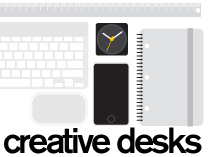.jpg)
.jpg)
.jpg)
.jpg)
.jpg)
“JACK” was designed to economically address the various ergonomic, technological, and aesthetic requirements of everyday work surfaces. JACK’s name arose from its resemblance to the children’s game of jacks, and is a lighthearted reference to the flexibility and skill involved. Human-like in its structural form, flexible in its physical configuration, and precise in its ability to intrinsically connect users to their work environment, JACK reinvents the common work table. The design process took place in-house over a period two years. The Jack table’s legs are comprised of replications of the same part, economically eliminating variations within the forms required to cast each leg or leg variety. Variations in the specific connection between leg components allow for a wide range of support configurations. JACK’s legs seem to stand on tippy-toes, belying the lateral stability gained through a splayed arm configuration. This inverted configuration limits the interference (both visual and physical) making the table-top appear to float. Acting as both shroud and structure the shallow “V” shape of the cable tray allows for a double function by simultaneously concealing common technological clutter (wires) and increasing the spanning capacity of the surfacing material. JACK has personality. Finding a work surface that allows users to economically address their size, work habits, and aesthetic tendencies has to date been virtually unattainable. Fabrication technology—specifically CNC routers—affords users the opportunity to ‘mass customize” the product to suit their individual needs. JACK takes advantage of the fact that, for this type of equipment, machining variety is no less efficient than machining similarity so the machining of the surfacing material provides literally limitless customization opportunities. JACK provides solutions only limited by your imagination.
click here for more
-joel
From the design studio of joel pirela, comes a curated collection of modern architecture, home accessories and current design trends.























